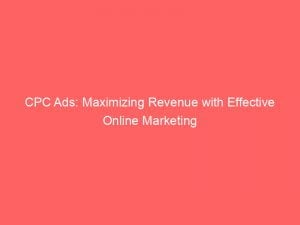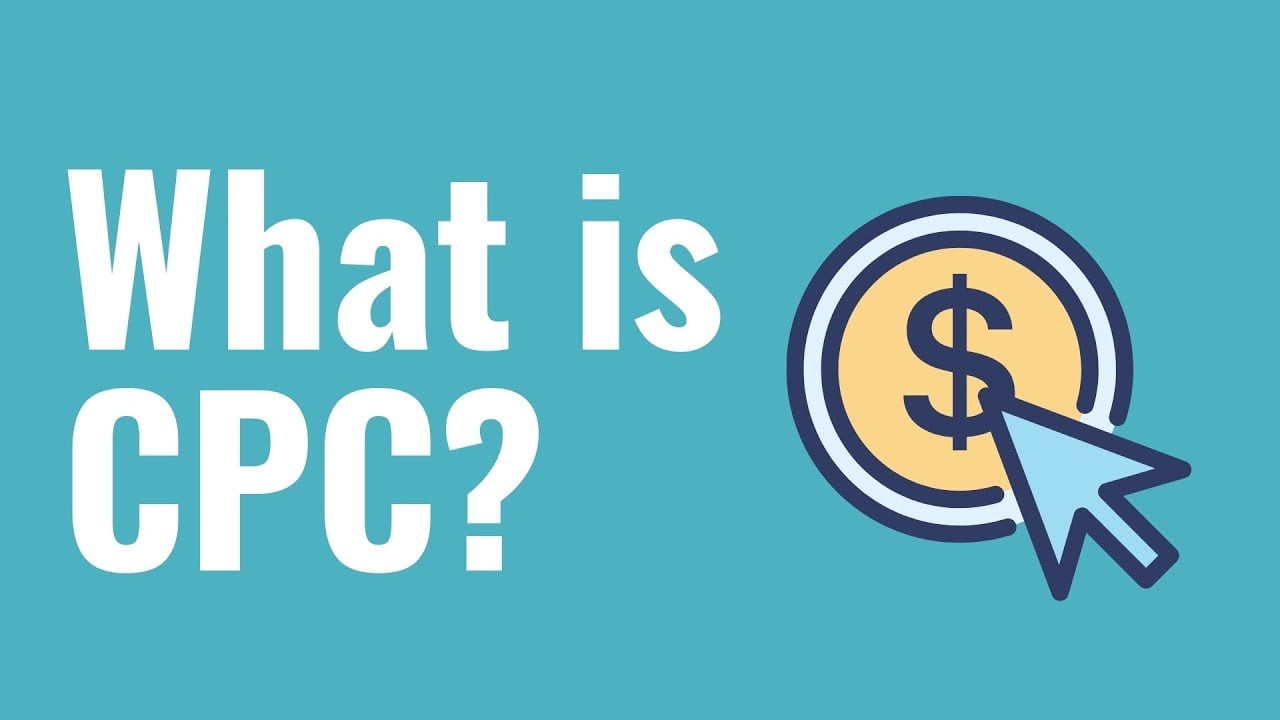In the fast-paced world of digital marketing, brands are constantly vying for visibility and engagement. Among the myriad of metrics that measure success, CPC ads stand out as a vital component.
Harnessing the power of actual clicks, CPC (Cost Per Click) provides invaluable insights into campaign performance. But wait, there’s more!
Enter CPM (Cost Per Mille), which focuses on ad views and offers a complementary perspective. By combining these two metrics, marketers unlock a comprehensive understanding of their audience’s behavior and optimize their ad strategies accordingly.
Join us as we delve into the intricacies of CPC bidding, max. CPC bids, and other budget considerations.
Let the adventure begin!
Table of Contents
cpc ads
CPC ads, also known as cost-per-clickads, are an essential aspect of measuring digital marketing metrics for brands. These ads enable advertisers to pay only when a user clicks on their ad, making it a valuable metric for tracking engagement and effectiveness.
CPC ads can be compared to CPM, or cost per thousand impressions, metrics, which measure the number of times an ad is viewed. While CPM focuses on ad visibility, CPC specifically measures the number of clicks received.
It is advisable for brands to consider using both metrics for a comprehensive understanding of their campaign performance.
When it comes to measuring CPC, it is based on the actual number of clicks received by an ad. Advertisers can bid on keywords and pay for each click their ad receives.
This bidding process involves setting a maximum cost-per-click bid (max. CPC), which is the highest amount an advertiser is willing to pay per click.
However, it is important to note that the actual CPC may be lower than the max. CPC bid, and advertisers are guaranteed that clicking on their ad will not cost more than the max.
CPC bid amount.
In the realm of CPC ads, advertisers have the choice between manual bidding and automatic bidding. Manual bidding allows advertisers to set a specific CPC bid for each ad group or keyword, offering more control over budget allocation.
Automatic bidding, on the other hand, lets the ad platform adjust CPC bids in real time based on factors like competition and keyword performance.
CPC ads are also referred to as pay-per-click (PPC) pricing, as advertisers only pay when someone clicks on their ad. For brands seeking more information on budgeting and bidding strategies, there are numerous articles available on the topic.
By efficiently measuring CPC ads, brands can gain valuable insights into their digital marketing campaigns and optimize their strategies for better performance.
Key Points:
- CPC ads are essential for measuring digital marketing metrics and tracking engagement and effectiveness.
- CPC measures the number of clicks received by an ad, while CPM measures the number of times an ad is viewed.
- Brands should consider using both CPC and CPM metrics for a comprehensive understanding of campaign performance.
- CPC is based on the actual number of clicks received by an ad, and advertisers can bid on keywords and pay for each click.
- Advertisers can set a maximum cost-per-click bid, but the actual CPC may be lower than the maximum bid.
- Advertisers can choose between manual bidding and automatic bidding in the realm of CPC ads.
Sources
https://support.google.com/google-ads/answer/116495?hl=en
https://advertising.amazon.com/library/guides/cost-per-click
https://www.investopedia.com/terms/c/cpc.asp
https://www.shopify.com/blog/what-is-cpc
Check this out:
💡 Pro Tips:
1. Tip: Conduct A/B testing to optimize your CPC ads
A/B testing involves creating two different versions of your ad and showing them to a segment of your audience to determine which version performs better. It is crucial for optimizing your CPC ads and improving their click-through rates.
2. Tip: Utilize demographic targeting to increase the effectiveness of your CPC ads
By targeting your ads to specific demographics such as age, gender, location, or interests, you can ensure that you are reaching the right audience. This can lead to higher conversions and a better return on your ad spend.
3. Tip: Improve your landing page experience to increase CTR
The landing page experience plays a critical role in improving your click-through rate. Make sure that your landing page is relevant to the ad copy, has clear navigation, and provides valuable content or offers to visitors. A better landing page experience can result in higher ad relevancy and user engagement.
4. Tip: Track and adjust your CPC bids regularly
Keep a close eye on the performance of your CPC ads and make adjustments to your bidding strategy as needed. Monitor how well your ads are converting and adjust your bids accordingly to avoid overspending or missing out on potential clicks.
5. Tip: Continuously optimize your ad copy and creative elements
Test different ad copy variations and creative elements to find what resonates best with your audience. Small tweaks in your headline, description, or visual elements can have a significant impact on the performance of your CPC ads. Regularly test and refine your ads to maximize their effectiveness.
Cpc Vs Cpm Metrics
When it comes to measuring the success of digital marketing campaigns, brands need to pay close attention to the metrics that matter. Two commonly used metrics in online advertising are Cost-Per-Click (CPC) and Cost-Per-Thousand Impressions (CPM).
Understanding the differences between these metrics is crucial for brands to make informed decisions and maximize their revenue.
CPC refers to the amount of money a brand pays for each click on their ad. On the other hand, CPM measures the cost for every one thousand ad views.
While both metrics provide valuable insights into campaign performance, there are distinct differences in how they are measured and what they reveal about audience engagement.
Understanding Click-Through Rate (CTR)
One essential metric to understand in the context of CPC ads is the Click-Through Rate (CTR). CTR is the ratio of users who click on a specific ad to the number of total ad impressions.
It is a measure of how successful an ad is in motivating users to take action and click through to the brand’s website or landing page.
Measuring Cpc: Actual Clicks
CPC is primarily measured based on the actual number of clicks an ad receives. This means that a brand will only be charged when a user clicks on their ad.
By measuring CPC, brands can gain insights into the effectiveness of their ad in attracting user attention and generating interest. It allows them to assess the return on investment (ROI) of their advertising efforts more accurately.
Measuring Cpm: Ad Views
In contrast, CPM is measured based on the number of ad views, regardless of whether users interact with the ad or not. It provides brands with an understanding of the reach and visibility of their campaigns.
By monitoring CPM, brands can evaluate the effectiveness of their ad placements and compare the cost of reaching a specific audience across different platforms or websites.
Benefits Of Using Both Metrics
While CPC and CPM provide valuable insights individually, using both metrics can offer a more comprehensive understanding of campaign performance. By analyzing CPC, brands can determine how well their ads are converting impressions into clicks.
On the other hand, CPM allows brands to assess the overall exposure and visibility of their ads. By considering both metrics, brands can make data-driven decisions and optimize their campaigns for maximum effectiveness.
Exploring Cpc Bidding And Max. Cpc
CPC ads involve a bidding system where brands compete for ad placement. Advertisers can set a maximum cost-per-click bid (max.
CPC) to indicate the highest amount they are willing to pay when someone clicks on their ad. This bidding strategy enables brands to control their advertising costs and allocate budgets efficiently.
Actual Cpc Vs Max. Cpc Bid
It is important to note that the actual CPC may be less than the maximum CPC bid. Factors such as competition, ad relevance, and the quality of the landing page can influence the actual CPC.
Brands should be aware that they won’t have to pay more than their maximum CPC bid amount for a click.
Ensuring Ad Clicks Stay Within Max. Cpc
To ensure that ad clicks stay within the maximum CPC bid, brands have the option of choosing between manual bidding and automatic bidding. Manual bidding allows brands to set bids for individual ad groups or keywords, giving them more control over their spending.
Automatic bidding, on the other hand, allows platforms to adjust bids dynamically based on the likelihood of conversion.
It is worth mentioning that CPC pricing is also known as pay-per-click (PPC) advertising. By utilizing this pricing model, brands can have greater control over their budget and ensure that they only pay for the actual engagement their ads receive.
In summary, measuring digital marketing metrics is of utmost importance for brands aiming to maximize their revenue through CPC ads. By understanding the differences between CPC and CPM metrics, brands can gain valuable insights into audience engagement and campaign performance.
Utilizing both metrics, along with monitoring CTR, allows brands to make informed decisions and optimize their advertising efforts for optimal results. With the ability to control bids and ensure that ad clicks stay within the maximum CPC, brands can effectively manage their spending and achieve their marketing goals.












